NIGHT RAT: Underground in MTL
by Kyra Sutton
Photography by Jade Garon and Yeonung Kim
005 / Zone Halte
Day 1 the bassin opens and sucks you in. The dancefloor absorbs you like quicksand—quicker than cars barrelling down the highway overhead. Through the dancers kicking up dust, two heels smack down against the platform: the pole dancer's legs swinging over ground. To your right, a raver dances up high, center scaffold, silhouetted by 5PM. Maybe it'll be your turn soon. But now each dancer faces the other: there is no front or back. You're on the same liminal ground, swapping spaces and footsteps: co-building the dancefloor.

Photo by Yeonung Kim
Access Point
"I don't have a long history of raving," Jérôme Thivierge, the founder of Halte, recounts to me in the days following the festival. "My first time hearing techno was at Tresor in Berlin," he says. "I wasn't hooked the first time, but what did hook me was the energy. It's not about the stage— it's about the dancefloor," he feels. "I'd rather be on the dancefloor."
"At the time I knew of the party scene, but hadn't gone deep into it." Jérôme has been making music since his teenage years, starting in shoegaze and alternative rock before experimenting with electronic styles. After studying in cultural and media production, he worked for various festivals and organizations in the city, including Mural Fest, MR-63 and Corridor Culturel. Through the later, he met Adam Dirhoussi and Alexandre Debarge, key collaborators in bringing Halte to life.
During his travels in Europe he applied to be a volunteer for Horst, a massive arts and music festival in Belgium. Located on former military terrain beside a nuclear plant, Horst innovates urban structures through blending art, music and architecture. "What I liked about this festival is that people didn't come for a specific sound— they came for the sound that the space created," he explains. "The space itself was the attraction. I'd ask, 'Who are you here to see?' and they'd say, 'I like these three but the rest, I don't care. I'll follow along.' I thought that was a beautiful thing."
Returning to Montreal, he began his research journey, digging deeper into the electronic music scene, looking at programming, festivals and curation. "Here we have an insane amount of great collectives, and great parties that come with them. But I always felt that they're very separate," he says of the multiplicity of genres and communities that make up Montreal's underground. "I've never had a preference. Sometimes it's more about what happens in the air that night, something special that sparks. It's less about the promoters," he suggests. With Halte, Jérôme aims to foster a similar atmosphere to Horst, where people come to experience the space, the vibe— not just a name on the lineup. "I think that's something we finally accomplished this year."
This became the mission for Halte: to bridge the gaps between communities. "We're literally under a bridge, trying to connect people," Jérôme remarks.

Photo by Yeonung Kim
Located under the Bonaventure Autoroute, the Peel Bassin hums with symbolic potential— a transitory zone between city and water, facing the remnants of Montreal's industrial era. "Gaps create differences, but my vision is that there is no difference," he says. "At the end of the day, we all love to dance. And dancing unites. I just wanted more people to share a dancefloor that normally wouldn't have come together."
On the name Halte: they wanted something grounded around the setting, and easily translated between French and English: "A road 'halte' is where you stop on a drive and take a breather," he explains. "You have your little sandwich and coffee." Halte asks you to slow down, to look around— "Stop, listen, absorb." Not to forget where you are, but to reimagine what that looks like.
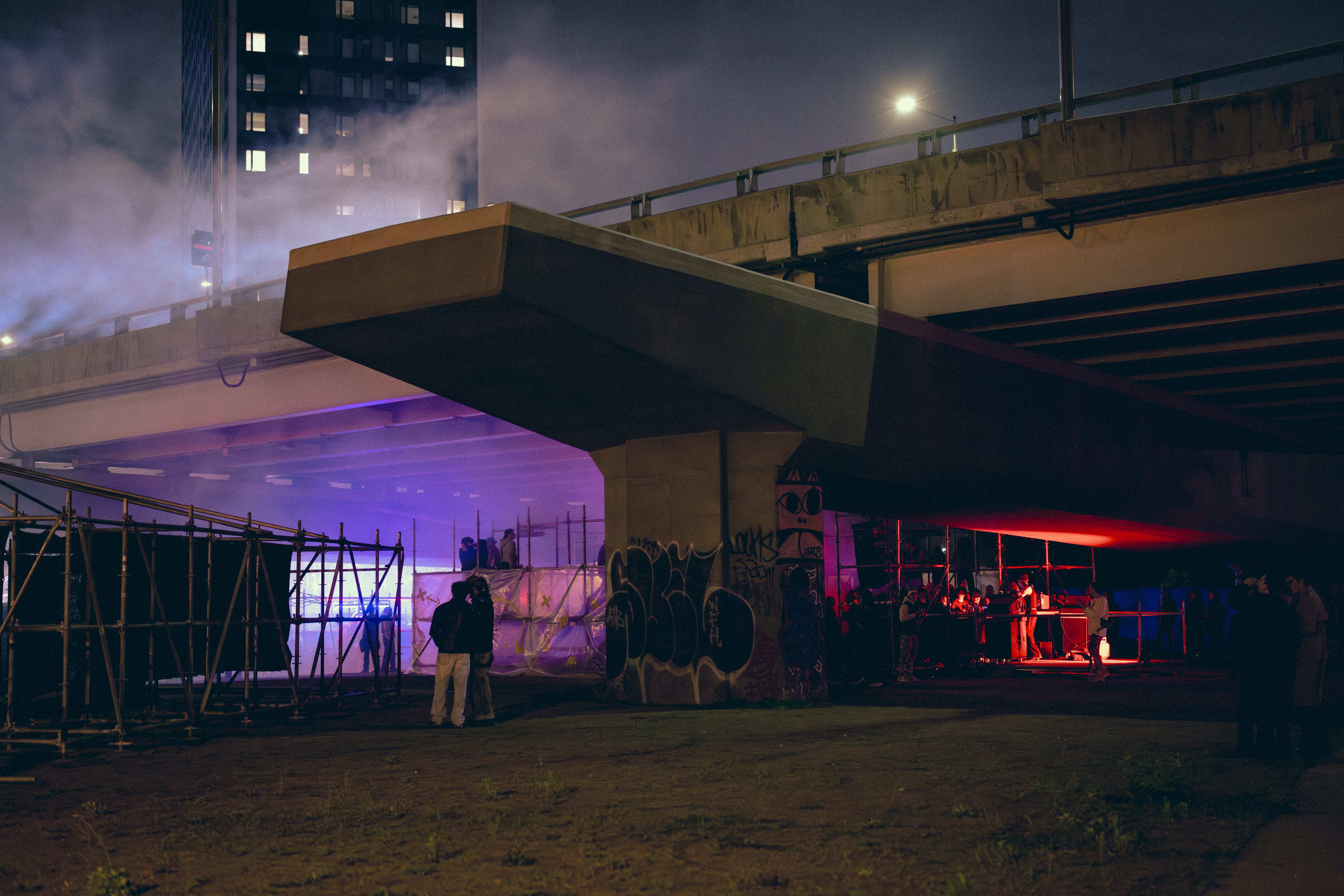
Photo by Jade Garon
Collective Infrastructure
Day 2 you're on the clock: safety monitor. You roam the grounds for trouble, but are hard pressed to find it. The easiest shift you've worked. No vomit to wash up yet, no calls made for an ambulance. One person checks their phone on the dancefloor— promptly puts it away. You survey the crowd from on top of the scaffold, glance at the smear of lights blurred across the skyline. The Farine Five Roses sign looms heavy like an anchor, indifferent to our gathering. It has been here long before and will be here long after.
*
For its pilot season last year, Halte collaborated with Blush, Supernature, Prohibition and Homegrown Harvest. In their second year, they continued to expand their reach, inviting Latex, OCTOV, Hauterageous and Autobahn as collaborators. "They worked very hard to make this happen with my team," Jérôme says. The lineup included local DJs such as Mossy Mugler, Divina, Frankie Teardrop, Pretty Privilege, and international talents like Elli Acula and Lyzza. "I don't want to book headliners just to sell tickets. Sixty percent are always locals," he says. "I want to include groups like OCTOV that have been running for ten years, but also Autobahn that is newer. I want to give them the chance to express themselves through programming."
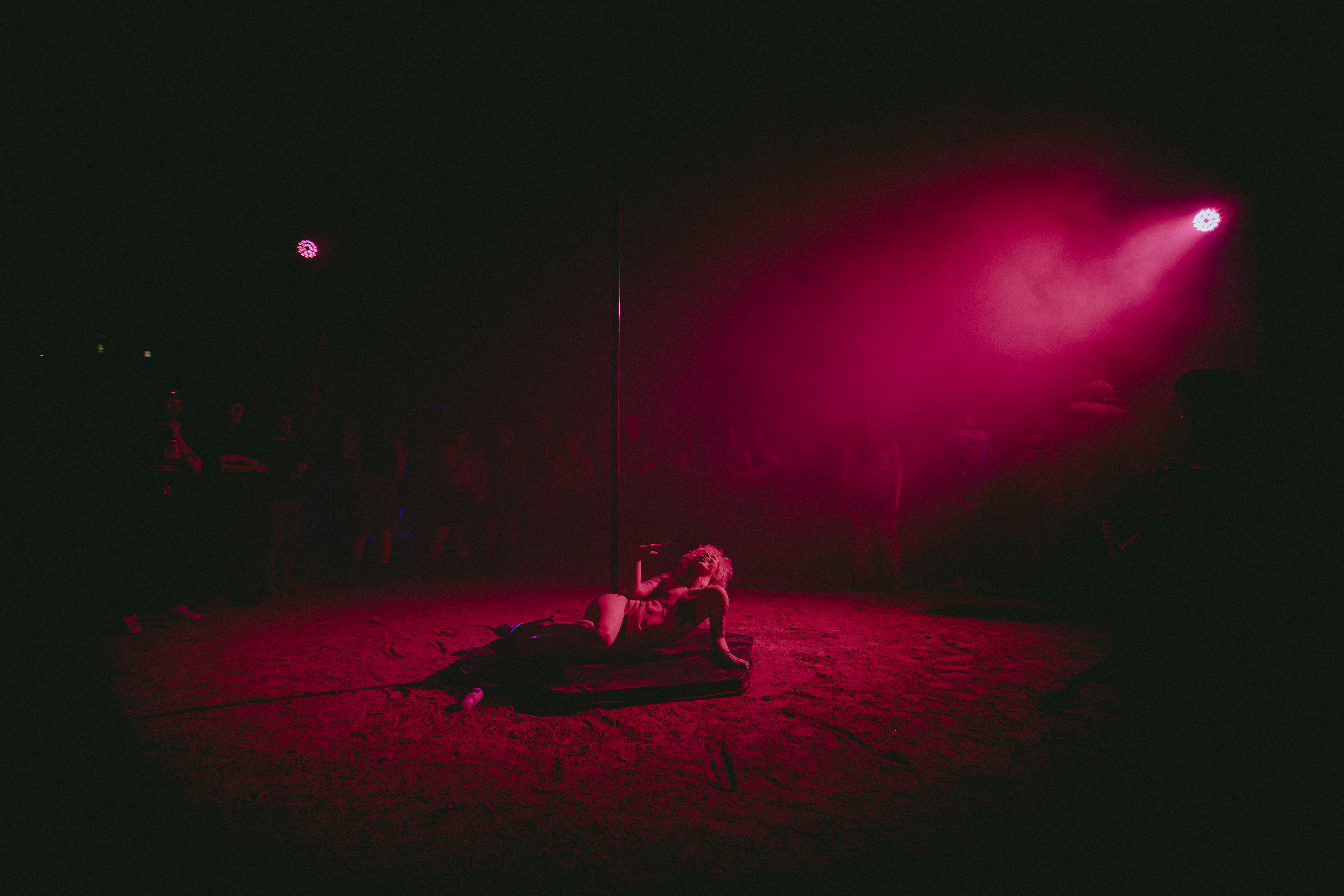
Ell Eros photographed by Jade Garon
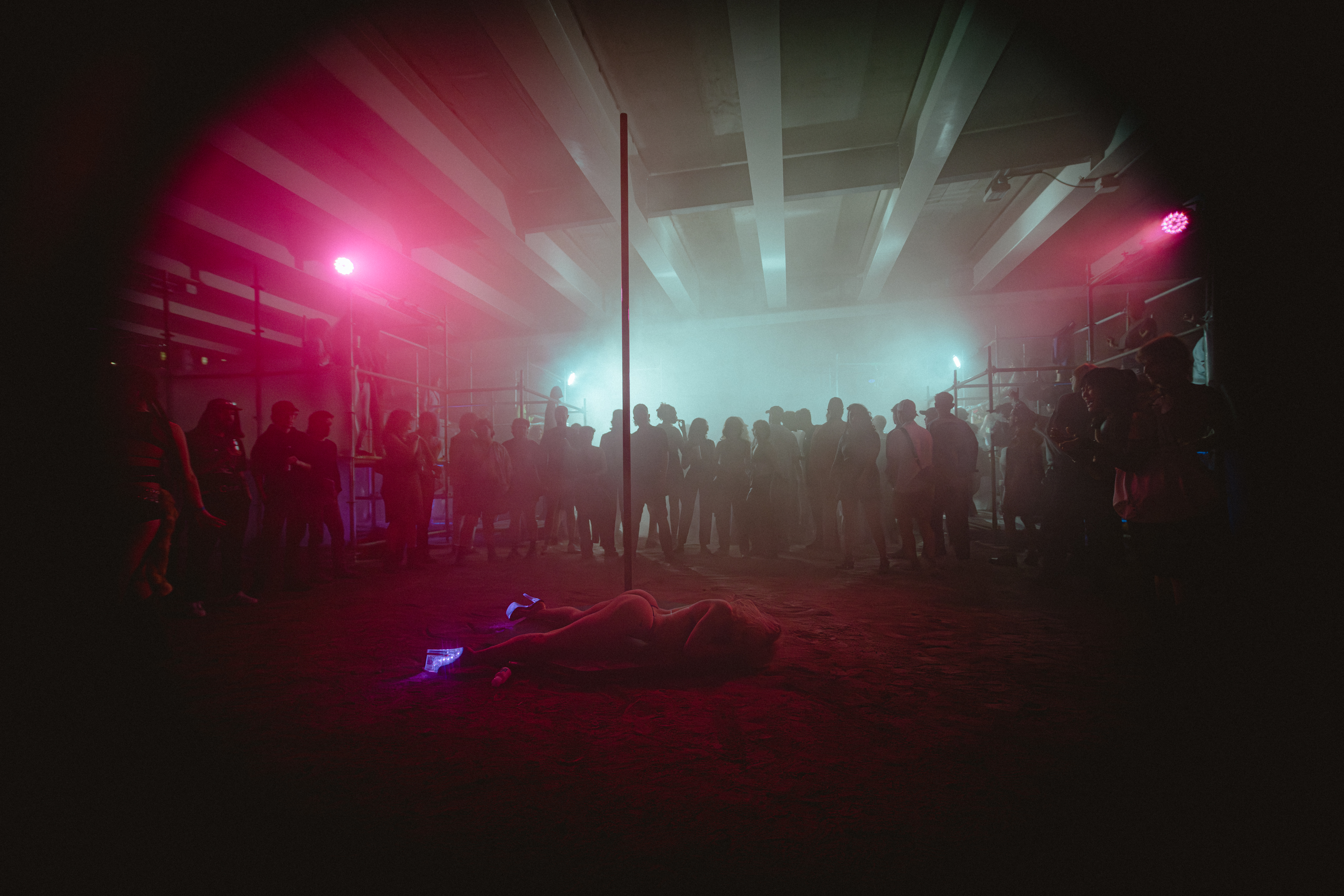
"We looked for collaborators more inclined towards techno. We wanted some difference, but also coherence," he explains. The result was that the festival was quite musically varied, with the intention that people would progress through the difference of each day. "My understanding is that when you listen to a sound that you're not familiar with, it's not that you don't like it. Most of the time, it's that you don't understand how to move through it yet."
Halte's collective structure also opposes the need for competition: "If you have six parties on the same night, then you have a bunch of events not filled up. As an organizer that's very stressful," he explains. "Why not just collaborate?"
The code of conduct is very important for Jérôme: "We read it to everyone when they arrive. We will always set the bare minimum for how to behave on the dancefloor." This of course includes a zero tolerance model for any discrimination— and no texting on the dancefloor.
Halte follows a NOTFALOF model, encouraging people to reach out if ticket prices are an obstacle. "We always want to keep prices low. We're not-for-profit and it will stay that way," he says. The motivator has always been deep reverence for the community: "It's for the DIY scene. It's for the underground. We're doing this to give back to our city."
Interim Ground
Day 3 is when the magic sparks. All elements shifting into place, springing from a foundation once shaky, now solid. Electricity whistles in the air. It's raining, it's cold. And you're still here. If you've made it this far, you can make it to the end. Soon the Peel Bassin will spit you back out, into the infrastructure of real-time. Swept up by the tide of present moment, flowing into the body of history.
*
Halte's specificity is rooted in the aesthetics of the scene— or rather, the scenography. Lights, structures, shadow, smell; all major or minor details that shape a sensory experience. How each aspect moves and interacts with the other.
Jérôme learned hands-on about building scenes through utilitarian structures during his time volunteering with the architecture team at Horst. Inspired by European projects like Temporary Pleasure and Club Dérive, Jérôme formed a scenography collective with friends and fellow architects, Fernanda Larrain and Ajwad Kabir. Interim Ground works in the in-between space of nightlife, where structures may be installed and disassembled all within the same day. "We always say we're building a playground for the underground," he says. "So— interim ground."
In response to my questions, the group answered as a collective body— their vision built in relation, like their work. "At Interim Ground, we've always been fascinated by post-industrial liminal spaces, sites of production left to ruin. Scenography becomes our way to work with these forgotten spaces, to give them new meaning through temporary rituals of gathering."

Photo by Jade Garon
In their approach to this year's layout, titled W.I.P. (Work in Progress), the Bassin Peel's unique geographical context served as a significant source of inspiration: "A vacuous plot of land under a freeway, overlooking the Farine Five Roses signage and, opposite it, the ever-encroaching vertical development in Griffintown. These types of sites are often targeted by new development. They get erased, replaced, overwritten. So we chose to work with the language of construction— not to mimic development, but to reclaim it," they say. "An open plot gives us the freedom to create our own 'set' —like a theater would. These are spaces that shift with use, invite participation, and make room for uncertainty."
Their conception was grounded in themes of construction and decay, permanence and impermanence: "We wanted to reflect the temporality of both the space and the gathering—always becoming, always in progress." Halte's scenography echoed symbols, markings and lines that the architects observed in the landscape, adopting mesh fabrics and materials common to construction sites. "Scaffolding becomes both a tool and a metaphor: it holds up, but never stays. It's meant to be taken down," they note. "In that, we find freedom."
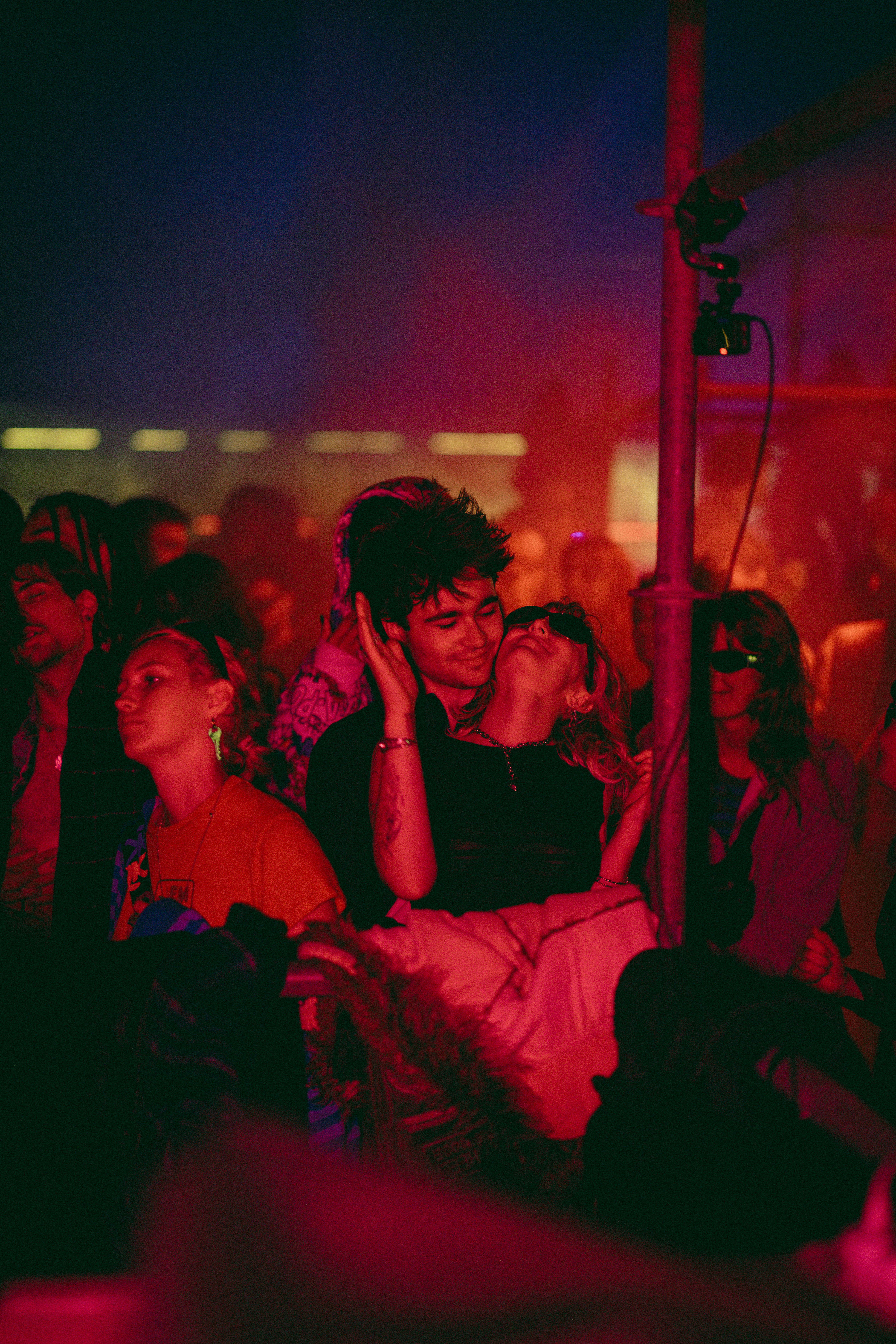
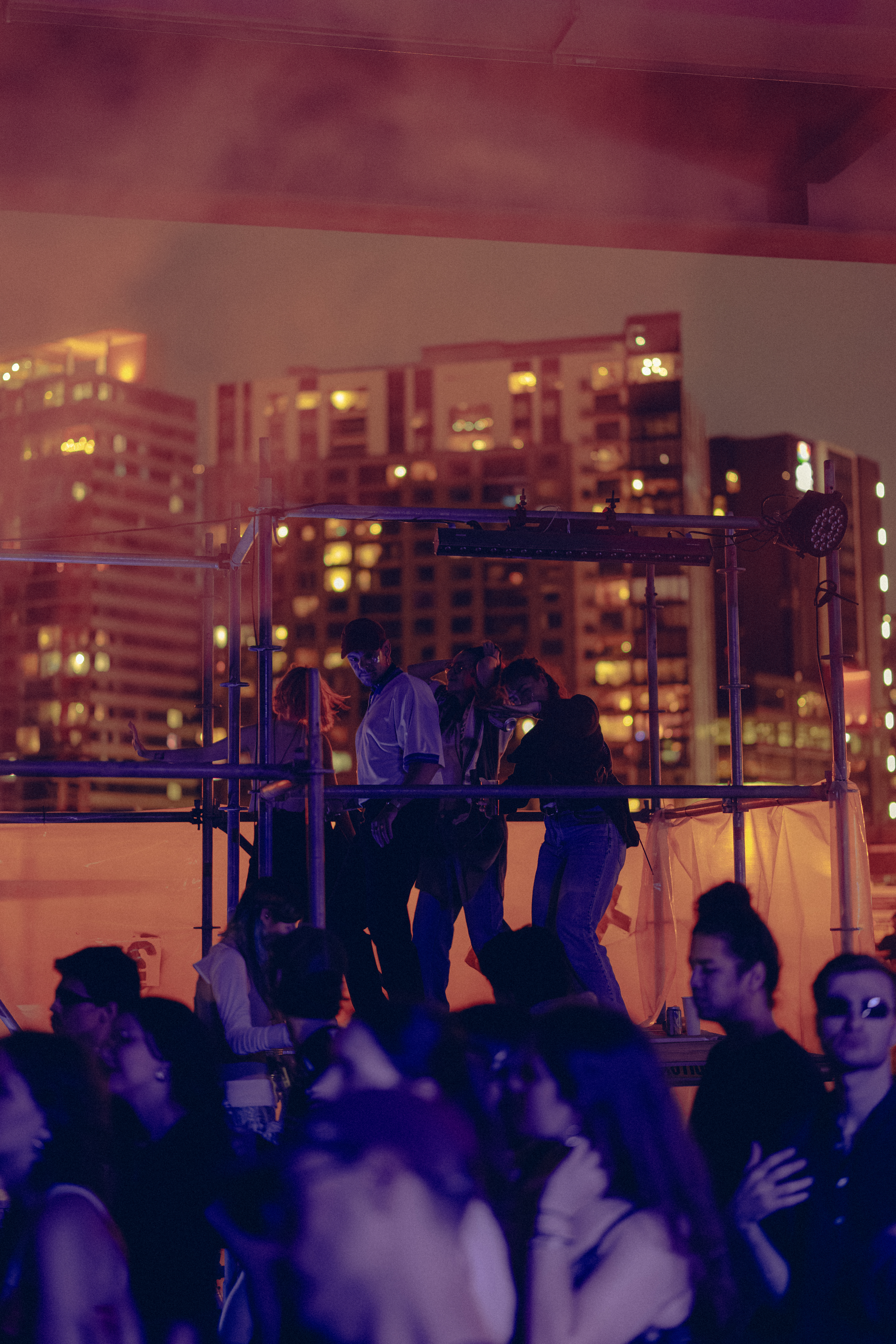
Photos by Jade Garon
"We imagined the main stage as a space for communication not just between the DJ and the dancers, but among the dancers themselves." Following an experimental setup last year, this year's scenography installation featured a three-tiered scaffolding structure, enclosing either side of the dancefloor in a permeable kind of intimacy. The different levels encouraged dancers to climb to the top for a panorama view of the bassin, or dance in between the bars on the middle platform. "The idea was that dancers on one side could see those on the other; or that someone on the ground could lock eyes with someone above, share a smile— maybe even have a little dance exchange from afar. Moments like that spark trust and joy," they say. "They give people the confidence to dissolve into sensation, to let go into a full-bodied experience."
The ravers are the final element in this construction, building the foundation of the dancefloor in real time. "Whether you were dancing, DJing, drinking, wandering, or just being there, the act of showing up transformed the space. Everyone contributed to this temporary transformation, helping embed a new sense of presence into a place usually overlooked," they say.
Other installations included Fieldwork, an outdoor exhibit featuring paintings, photos, and other works by visual artists. Church of Sound was a haven of immersive, downtempo soundscapes, pre-recorded by a selection of DJs and programmed in collaboration with local legend Honeydrip. "We had to change plans last minute and improvise on the spot," Jérôme recalls. "But that's kind of the DIY scene— it's not perfect and will never be. We're still learning and trying to have fun with it."
Outside of Halte, Interim Ground has also curated scenography for T.I.T.S. Collective.

Photo by Yeonung Kim
As for the future of the festival, it will continue to transform. "We still need to gain trust from the communities, from the dancers," Jérôme adds. "That will come with time." He hopes to build a second dancefloor and deepen the artistic foundations of the project, bringing in more works, more artists, more collaborations. Halte plans to host a discussion panel before the next festival to compare nightlife activities in other cities.
In the meantime, the team is imagining something special before next summer. "If anyone wants to work with us and has a skill to share, reach out. We'll be glad to discuss. We really do want to bring people together."
People go home, structures fall— the spaces remain, echoes bouncing against concrete in the aftermath. Maybe you left some sweat in the dust of the underpass. Maybe it'll cement there by next year. Or maybe the canal has already pulled it downstream.
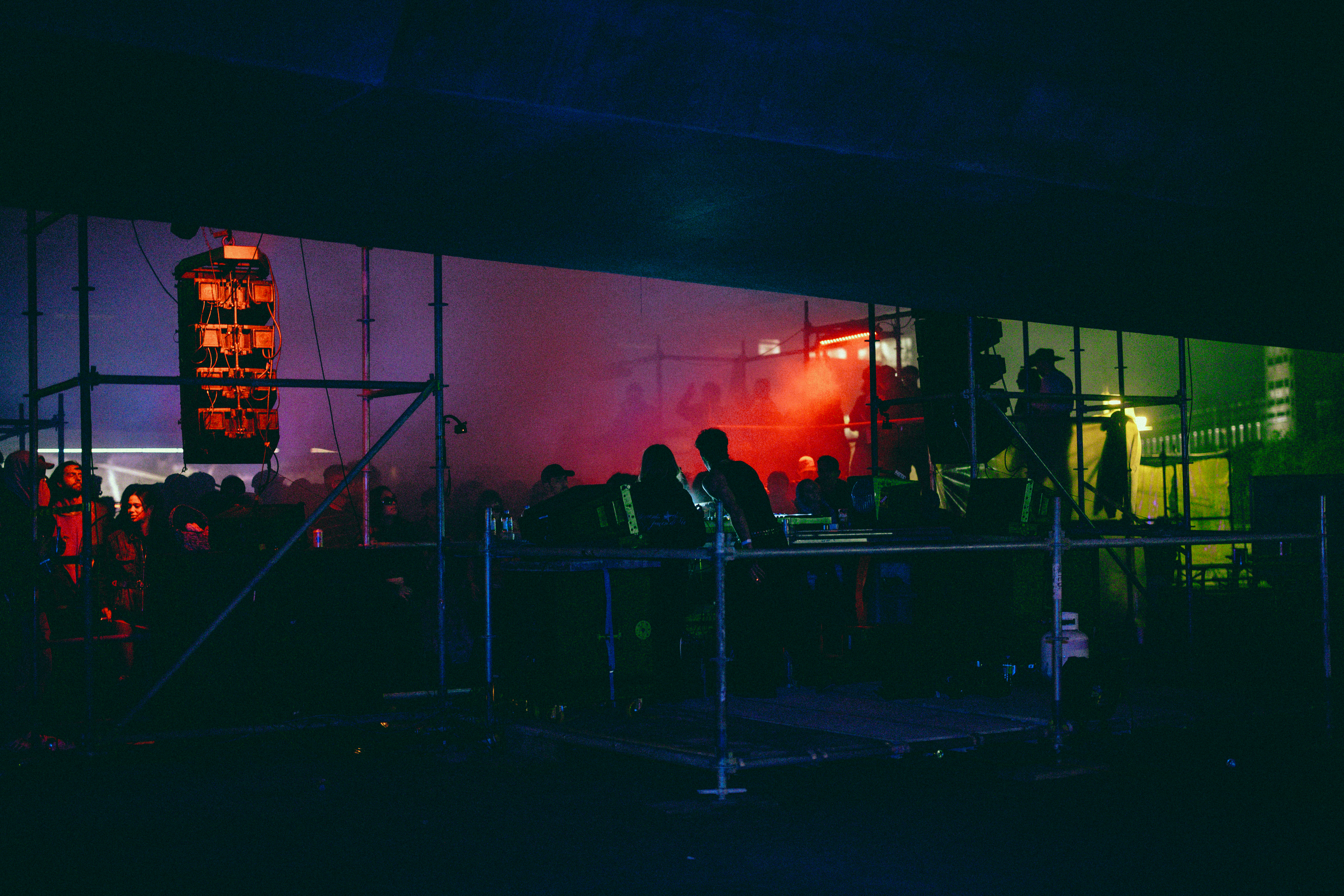
Photo by Jade Garon

